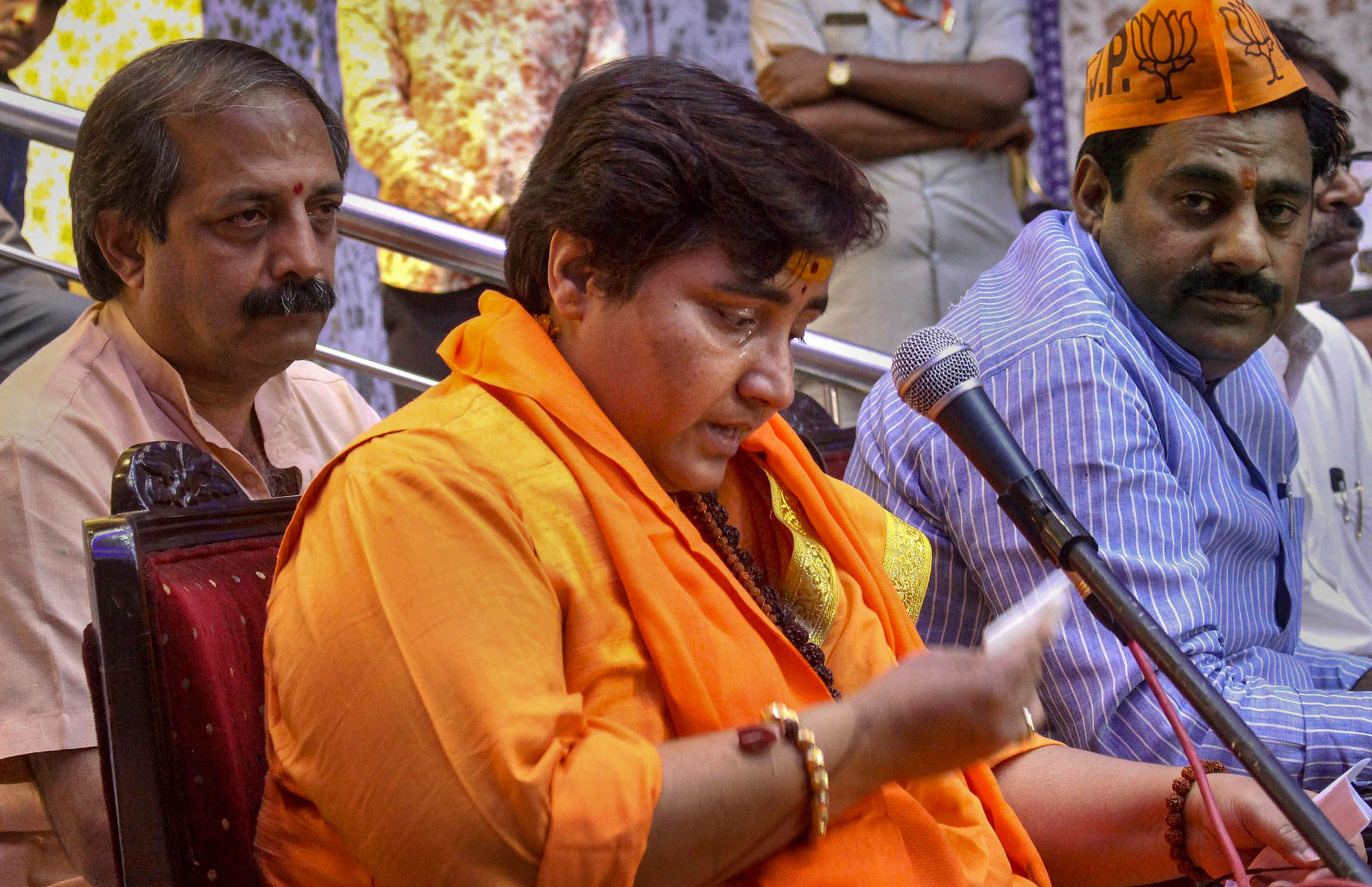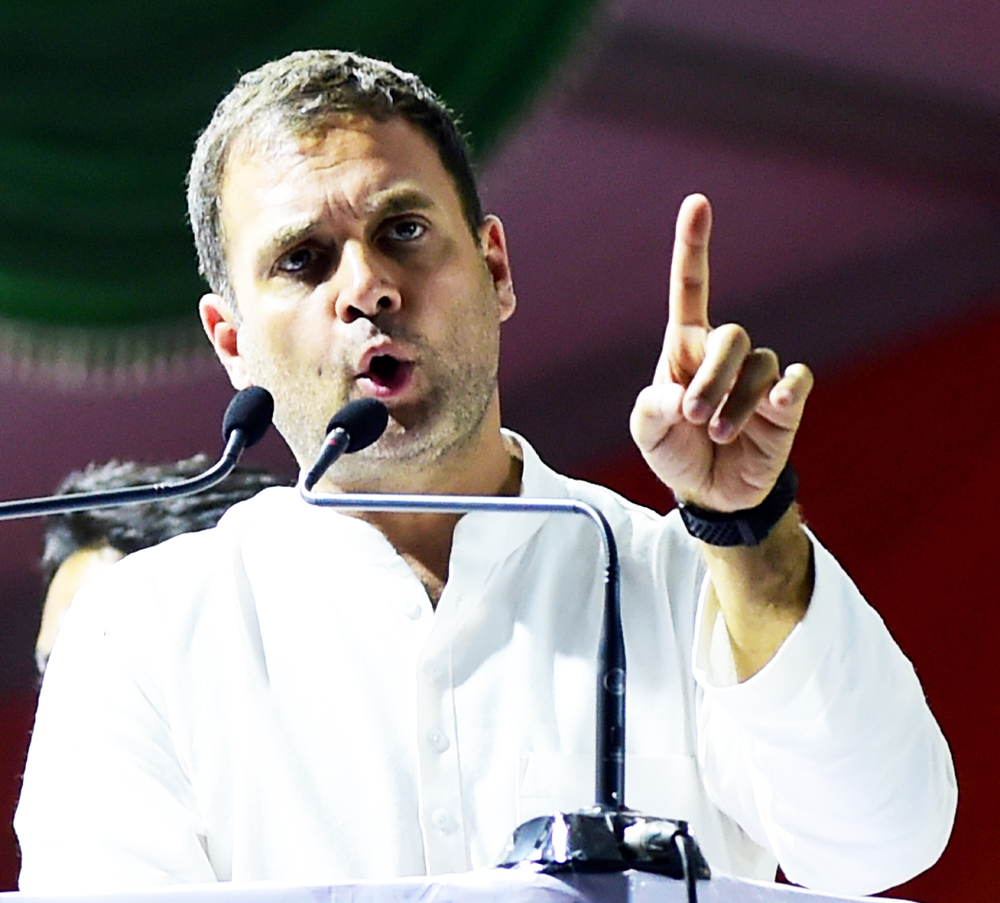For the religious Hindu, saffron is the colour of sacrifice, of piety, of renunciation. For proponents of political Hindutva — the Rashtriya Swayamsevak Sangh, Bharatiya Janata Party, Vishwa Hindu Parishad and their numerous cohorts — it is the opposite. Saffron, for them, denotes aggression and intimidation, venom and violence, brute power of the “majority” over imagined and invented enemies.
It is this understanding of saffron that lies behind the BJP’s decision on April 17 to field Pragya Singh Thakur, who calls herself a sadhvi, against the former Congress chief minister, Digvijaya Singh, from the prestigious Lok Sabha seat of Bhopal.
Many a supporter of Narendra Modi and his “development” agenda was shocked at the decision. The saffron-robed Pragya Thakur, after all, is a key accused in the 2008 Malegaon blast that killed six people and left over a hundred wounded. She was arrested and imprisoned under the Unlawful Activities (Prevention) Act for conspiring and abetting an act of terror and faces charges that include criminal conspiracy and murder. She is out on bail but has not been acquitted.
The special court, in fact, rejected Pragya’s plea seeking discharge from the case after the National Investigation Agency — which took over the case from the Maharashtra anti-terrorist squad — gave her a clean chit.
That sense of shock deepened when Pragya Thakur proudly claimed that the late chief of the Maharashtra ATS, Hemant Karkare, had met his death because she had cursed him. Karkare had died during the terror attack in Mumbai on November 26, 2008 — or 26/11 as it has gone down in history. Two months before he was killed fighting Pakistani terrorists, Karkare had arrested Pragya and her associates for plotting terror attacks.
Karkare, posthumously awarded the Ashok Chakra for his bravery, became a national hero after his death. But that did not deter Pragya Thakur from exulting over his death and taking credit for it. Karkare, she claimed, had tortured and abused her. She had cursed him in return, and “within 45 days”, her curse had had its effect: the police officer had been slain.
Pragya Thakur’s comment was so outrageous that even serving police officers — who are otherwise too scared to speak out against the ruling party — came out with a statement in protest. Retired officers and political parties were much more forthright in condemning her.
Yet, barring a bland statement praising Karkare’s bravery, the BJP refused to reprimand Pragya Thakur in any way. Rather, it defended her statement, describing it as a “personal opinion, possibly due to the years of physical and mental torture that she faced.”
Some have argued that the decision to field Pragya Thakur and then defend her odious utterances has been done at the behest of the RSS. This is only partially true. The RSS, of course, is a champion of Pragya and her ilk who belonged to extremist Hindutva groups and were charged with violent crimes that came under the broad rubric of “Hindu terror” or “saffron terror”.
But the prime minister is himself Pragya Thakur’s biggest supporter — for she is the ideal mascot to convey two central and intertwined Hindtuva themes: the Hindu as the “victim” and the Hindu as the “avenger”.
More than two weeks before the BJP welcomed Pragya Thakur into its ranks, Modi had unveiled his new offensive that anticipated her candidature. Addressing an election rally in Wardha on April 1, Modi referred to the acquittals of four accused in the Samjhauta Express blast case to lambaste the Congress for “committing the grave sin” of accusing Hindus of acts of terror.
“The Congress,” he thundered, “attempted to taint crores of people of this country with Hindu terror. Tell me, did you or did you not feel deeply hurt when you heard the word Hindu terror? Has there been any incident of Hindus resorting to terror in the history of thousands of years? Any one incident? Even British historians never mentioned that Hindus resorted to violence. Who tried to defame our culture of over 5,000 years?”
The Congress, wary of Hindu “consolidation” at election time, refused to enter the debate. Other political parties, too, would rather stick to issues of jobs and farmers’ distress than enter a communally charged minefield. But as citizens outside the electoral fray with no such compulsions, we are free to dissect Modi’s pastiche of lies and myths that distort both history and contemporary reality.
The truth is human beings throughout history have resorted to terror and violence from time to time and Hindus are no exception. The inhumane and unequal caste system, for instance, has been held in place by the perpetual and pervasive threat of violence. Buddhism was driven out from the land of its origin by means that were not exactly peaceful. Even a cursory reading of history books would tell us how the British loathed and feared the “Hindu terrorist” when revolutionary groups of young men and women threatened their rule — parallel to the Gandhian movement — in the 1920s and 1930s, particularly in provinces such as Bengal. And let us not forget that Mahatma Gandhi was assassinated by a Hindu extremist.
As for the “saffron terror” cases of more recent origin, the prime minister was being extremely economical with the truth when he claimed that all of them had been fabricated by the previous United Progressive Alliance governments. Hindu extremist groups were implicated in half a dozen terror attacks — Malegaon in 2006 and 2008; Samjhauta Express, Ajmer Sharif and Mecca Masjid in 2007 and Modasa in 2008.
In the Ajmer blast, the special court in Jaipur convicted three former RSS pracharaks in 2017. The accused in other cases, such as Swami Aseemanand, was acquitted for lack of evidence. The cases fell through because the NIA, after the change of government, failed to pursue them vigorously. The courts, in fact, pulled up the NIA for shoddy investigation. They did not rap them for cooking up false cases.
More significantly, in December 2018 — when the BJP headed governments both in Delhi and Mumbai — the Maharashtra ATS chargesheeted a dozen men belonging to extreme Hindutva outfits (such as the Sanatan Sanstha and Hindu Janajagruti) under the UAPA for plotting terror attacks. The charge sheet described them as a “terrorist gang” seeking to establish a “so-called Hindu Rashtra”.
But if these related to conspiracies by secret terror groups, Modi himself drew attention to the more overt violence that has been ubiquitous in India and explodes the myth of the intrinsically peaceful Hindu. In a recent television interview, Modi defended the choice of Pragya Thakur by referring to the 1984 anti-Sikh riots in Delhi and describing it as an “act of terror”. He seemed oblivious to the fact that by the same token, the riots in Gujarat under his watch were also a case of terror. Riots apart, the targeted lynching of cattle traders and the killing of men for wearing a skull cap or allegedly storing beef in their refrigerator are instances of majoritarian terror, which has become the new normal over the past five years.
Acts of violence and terror are carried out by human beings as a result of historical circumstance or ideological indoctrination and have little to do with the religion one is born into. Buddha may have been the world’s greatest pacifist but that hasn’t stopped Buddhists from committing great acts of violence in our own neighbourhood of Sri Lanka and Myanmar. The same is true for all religions without exceptions — their adherents can be apostles of peace and love; and also be driven to hate and violence.
The real irony is that the RSS and BJP claim Pragya Thakur is a “victim” of the false taint of “Hindu terror” and her fight against Digvijaya Singh is to avenge the Congress’s “sin” of insulting Hindus. But like the decision to anoint the hate-spewing “Yogi” Adityanath as the UP chief minister, with the choice of “Sadhvi” Pragya Thakur, the Modi regime has only bared its own terrifying saffron fangs. And given us ample warning of the overt violence and silent terror that lies in store if the forces of Hindutva return to power once more...












